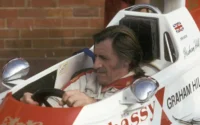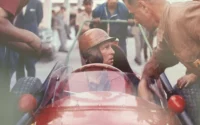Embassy Racing with Graham Hill, better known simply as Embassy Hill, was one of Formula One’s shortest-lived, yet most fascinating teams. Launched by none other than two-time World Champion Graham Hill himself, it carried all the flair you’d expect from one of F1’s great characters.
The outfit debuted in 1973, running a customer Shadow DN1, and by 1975, it had graduated to building its own cars. Success was limited, but the team seemed to be gathering momentum until fate intervened. A light aircraft crash in late 1975 claimed the lives of Hill, rising star Tony Brise, and several key team members, abruptly ending the project before the 1976 season could begin. Sponsored by Imperial Tobacco’s Embassy cigarette brand, the team appeared in various guises, but is remembered today as one of motorsport’s most tragic “what-ifs.”
Origins: 1972–1973
The story begins in late 1972, when Graham Hill, disillusioned with life at Brabham, decided to go it alone. Announcing he would form his own team, he took on the dual role of owner and driver. Headquarters? Not a gleaming factory, but a modest warehouse on an industrial estate in Hanworth, West London. With a crew of about 20 engineers and mechanics and vital sponsorship from Embassy, Hill got his dream rolling.
The team’s debut came with a customer Shadow DN1. But despite Hill’s pedigree, the first year was tough. At Zolder, Hill dragged the car home in ninth place, which sounds respectable until you note it was last of the nine finishers, having started dead last on the grid in 23rd. A humbling start for a double World Champion.
1974: The Lola Years
For 1974, the team upgraded to the Lola T370, essentially a Formula 5000 chassis adapted for Formula One. Hill drove all season and managed to nick a single point at the 1974 Swedish Grand Prix. That, however, was as good as it got. The second seat was a revolving door: Guy Edwards, Peter Gethin, and Rolf Stommelen all had turns behind the wheel, with little to show for it.
1975: The GH1 and the Arrival of Brise
The T370 lingered at the start of 1975 until the team’s “own” car was ready. Initially badged as the Lola T371, designer Andy Smallman’s creation was re-christened the Hill GH1 after he left Lola to work exclusively for Embassy Hill. Although heavily influenced by Lola designs, it was a milestone, the team’s first step as a constructor.
Tragedy struck almost immediately. At the 1975 Spanish Grand Prix, Stommelen’s rear wing mounting failed while he was leading the race. His car crashed into the crowd, killing four spectators. Stommelen himself was badly injured and sidelined for months.
Meanwhile, Graham Hill’s own driving career was winding down. After failing to qualify for Monaco, a race he’d won five times, he stepped out of the cockpit. The torch was passed to Tony Brise, a brilliant young driver widely regarded as Britain’s next big thing. Brise quickly impressed: sixth place in Sweden, sixth on the grid at Monza.
The team also leaned on Alan Jones, who stepped in during Stommelen’s absence and scored a fine fifth at the 1975 German Grand Prix. François Migault and Vern Schuppan also appeared in the second car, but it was Brise who gave the team its spark of hope for the future.
1976 Plans: The Hill GH2
Andy Smallman’s next creation, the Hill GH2, was the first car designed entirely in-house for Embassy Hill. Powered by the trusty Cosworth DFV, the GH2 was sleek and modern, drawing comparisons with the Brabham BT44 and McLaren M23. Brise began testing it in the summer of 1975, and by the November Paul Ricard test the car looked genuinely competitive. Faster, more stable, and easier to drive than the GH1. For once, optimism filled the garage. The dream, however, never made it to the grid.
The Plane Crash
On the evening of 29 November 1975, Hill piloted the team’s Piper Aztec back from Paul Ricard to London. On board were team manager Ray Brimble, designer Andy Smallman, mechanics Terry Richards and Tony Alcock, and star driver Tony Brise. They were due to land at Elstree Airfield before heading into the city for a party.
Thick fog enveloped the approach. Just before 10 pm, the plane clipped trees beside a golf course at Arkley and crashed, bursting into flames. Everyone on board was killed.
The loss was catastrophic. With only deputy manager Allan Turner and two mechanics surviving outside the flight, the team simply could not continue. Embassy Hill folded almost overnight. Most of its assets were acquired by Walter Wolf, who merged them with remnants of Hesketh and Frank Williams Racing to form his own team.
Hill Formula One World Championship Records
| First entry | 1973 Spanish Grand Prix |
|---|---|
| Races entered | 41 |
| Constructors | Shadow-Ford Lola-Ford Hill-Ford |
| Drivers’ Championships | 0 |
| Race victories | 0 |
| Pole positions | 0 |
| Fastest laps | 0 |
| Final entry | 1975 United States Grand Prix |
Hill Constructors’ Championship Results
Entrant Names
| Years | Name |
|---|---|
| 1973 | Embassy Racing |
| 1974–1975 | Embassy Racing with Graham Hill |
As Entry
| Year | Chassis | Engine | Tyre | No. | Drivers | Rounds |
|---|---|---|---|---|---|---|
| 1973 | Shadow DN1 | Ford Cosworth DFV 3.0 V8 | G | Graham Hill | 4–15 | |
| 1974 | Lola T370 | Ford Cosworth DFV 3.0 V8 | F | 26 | Graham Hill | All |
| 27 | Guy Edwards | 1–2, 4–11 | ||||
| Peter Gethin | 10 | |||||
| Rolf Stommelen | 12–15 | |||||
| 1975 | Lola T370 | Ford Cosworth DFV 3.0 V8 | G | 22 | Graham Hill | 1–3 |
| 23 | Rolf Stommelen | 1–2 | ||||
| Lola T371 | 3 |
As Works
| Year | Chassis | Engine | Tyre | No. | Drivers | Rounds | WCC Points | WCC Pos. | Report |
|---|---|---|---|---|---|---|---|---|---|
| 1975 | GH1 | Ford Cosworth DFV 3.0 V8 | G | 22 | Rolf Stommelen | 4, 12–13 | 3 | 11th | Report |
| François Migault | 6 | ||||||||
| Vern Schuppan | 7 | ||||||||
| Alan Jones | 8–11 | ||||||||
| 23 | François Migault | 4 | |||||||
| Graham Hill | 5 | ||||||||
| Tony Brise | 6–14 |





